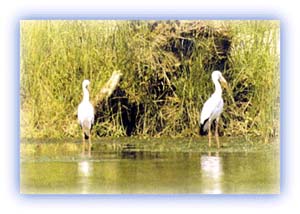Flora and fauna
General Info
· Flora
· Tropical Forests
· Temperate Forests
· Sub-alpine forests
· Alpine scrubs
Mammals
· Cats
· Dog Family
· Bears
· Weasel Family
· Rodents
· Horse Familiy
· Yak
· Wild Yak
· Bharal
· Ibex
· Deer
· Birds
Why are these animals endangered?
How much money do the poachers make?
Protected Areas
· Nepal
· India

![]()
|
Fauna Matching the plant world, the animal kingdom in the Himalayas also show fantastic diversity. These animals are also remarkably different from other animals found elsewhere in the Indian subcontinent, for example, the plains of India. The diversity in wildlife is tremendous - be it in case of mammals, birds, reptiles, amphibians or even fishes, in the Himalayan lakes. These animals live in various habitats, ranging from dry temperate forests to areas above the tree line. |
 |
| Storks Credit: Rajesh Shrestha |
Like the plant kingdom, the animals also need to adapt with the conditions in the mountains like the biting cold, the lack or excess of rainfall in certain parts, the increase in altitude. Several behavioral and physiological adaptations have developed in these animals due to the extreme climatic conditions present in many parts of the Himalayas. For example, many animals seasonally migrate in search of food and better living conditions. Many travel from lower altitudes to higher elevations in summer in search of alpine grass. In winters, the animals tend to come down to lower altitudes to survive the bitterly cold winds. Some animals hibernate in winter while others resist the cold with the help of their thick fur and bushy tails. In higher altitudes, to cope up with the rarefied air, animals have larger nasal cavities.
Mammals
Carnivores are the most elusive of all mammals in the Himalayas,
especially in the barren cold deserts. There are a variety of
carnivores in the higher mountains, some of which are rare and
threatened with extinction. These animals were indiscriminately
hunted in the past and now face competition from domestic stock. This
has had an adverse effect on the predator populations
which barely manage to survive in these fragile ecosystems.
All rights reserved